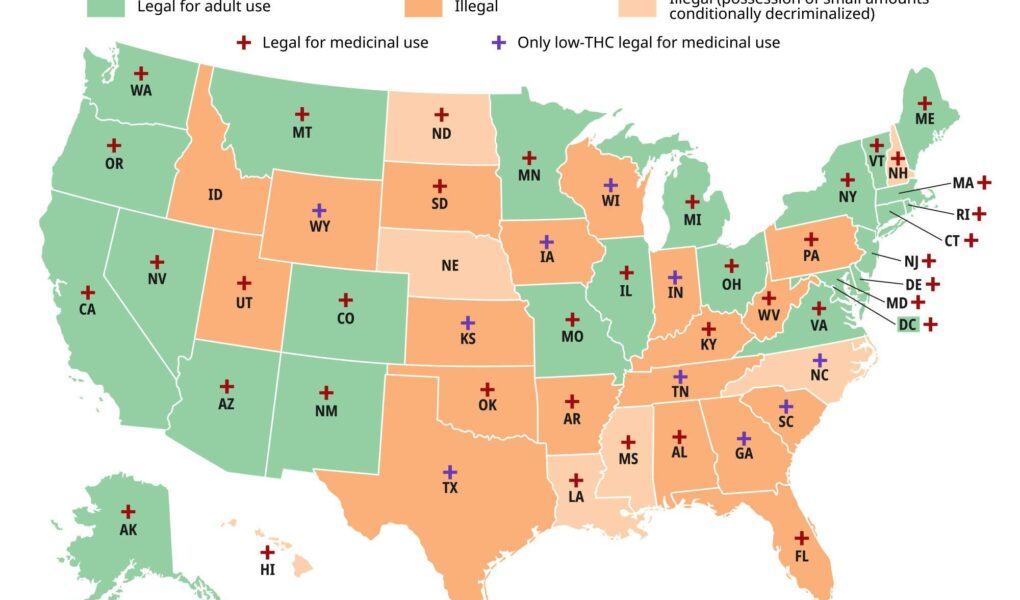In the evolving landscape of American society, few topics have generated as much discussion and debate as cannabis. Once relegated to the shadows of legality and stigma, cannabis has emerged into the mainstream consciousness, reshaping cultural norms and legal frameworks across the nation. As states take divergent paths—some embracing full legalization, others opting for medicinal use, and a few maintaining strict prohibitions—a complex tapestry of “cannabis states” unfolds. This article delves into the nuances of these various approaches, exploring the legal, economic, and social implications of a rapidly changing cannabis landscape. From thriving markets to ongoing legal battles, join us as we navigate the intricate world where policy, perception, and plant converge.
Table of Contents
- Exploring the Legal Landscape of Cannabis States
- Understanding the Economic Impact of Cannabis Legislation
- Navigating the Health Benefits and Risks of Cannabis Use
- Community Perspectives: Engaging with Local Cannabis Culture
- Q&A
- Future Outlook
Exploring the Legal Landscape of Cannabis States
The legal landscape surrounding cannabis varies dramatically across the United States, reflecting a tapestry of local ideals and legislative progress. States that have embraced cannabis reform exhibit a rich diversity in their approaches, whether through adult-use legalization, medical provisions, or decriminalization efforts. Key factors shaping these differing frameworks include public opinion, state governance, and the economic incentives of cannabis markets. Those looking to explore deeply can examine how regulations regarding cultivation, distribution, and consumption impact local economies and social issues. The conversation around equity and access continues to evolve, as states work to remedy past injustices linked to marijuana prohibition while balancing new regulatory frameworks.
When one considers the current status of cannabis legality, it’s fascinating to observe how certain states have become trendsetters, while others remain more conservative. Some possess comprehensive systems for licensing cannabis businesses, fostering innovation, and driving tax revenue, while others are experimenting with pilot programs. Here’s a brief overview summarizing diverse state strategies:
| State | Legal Status | Implementation Type |
|---|---|---|
| California | Legal for Adult Use | Regulated Market |
| Colorado | Legal for Adult Use | Regulated Market |
| New York | Legal for Adult Use | Emerging Market |
| Texas | Medical Use Only | Limited Access |
| Florida | Medical Use Only | Regulated System |
This diversity paints a picture not just of varying legality, but also of cultural attitudes towards cannabis itself. Attention to public health, safety, and community impact continues to shape policies as states negotiate their way through the complexities of a rapidly changing landscape. As legal frameworks drift and shift, the focus on sustainability and responsible use remains paramount, urging stakeholders to create systems that benefit all facets of society.
Understanding the Economic Impact of Cannabis Legislation
The shift toward cannabis legalization has ushered in a new chapter for economies across various states. As legislation evolves, it opens up avenues for considerable revenue generation and job creation. States that have embraced legalization have reported significant increases in tax revenues, which can be channeled into essential services such as education and infrastructure. For instance, the following aspects illustrate the economic surge associated with cannabis legislation:
- Tax Revenue: Cannabis taxes provide a substantial boost to state coffers, enabling further development.
- Job Creation: From cultivation to retail, the industry generates thousands of jobs, contributing to lower unemployment rates.
- Tourism Growth: Legalized cannabis attracts tourists, which benefits local businesses and hospitality sectors.
Moreover, the impact extends beyond financial metrics, influencing market dynamics and social attitudes. As industries adapt to this new regulatory landscape, consumers are presented with a broader range of products, from edibles to medicinal options. These changes also promote a cultural shift, forming new community norms and values surrounding cannabis use. Consider the following table that showcases some key data points reflecting the economic impact in select states:
| State | Year Legalized | 2022 Tax Revenue ($) | Jobs Created |
|---|---|---|---|
| California | 2016 | $1.3 billion | 100,000+ |
| Colorado | 2014 | $423 million | 41,000+ |
| Illinois | 2020 | $445 million | 40,000+ |
Navigating the Health Benefits and Risks of Cannabis Use
The evolving landscape of cannabis legality across various states has resulted in an intricate tapestry of health implications. Users often report a myriad of benefits, including:
- Pain relief: Many find that cannabis alleviates chronic pain conditions.
- Anxiety Reduction: Some strains help in managing anxiety and stress.
- Improved Sleep: Cannabis may assist those suffering from insomnia by promoting relaxation.
- Appetite Stimulation: Particularly beneficial for those undergoing treatments like chemotherapy.
However, it is equally important to acknowledge the potential risks associated with cannabis consumption. These may encompass:
- Cognitive Effects: Regular use can impair memory and concentration.
- Dependency Issues: Some individuals may develop a psychological dependence on cannabis.
- Respiratory Problems: Smoking cannabis can lead to similar respiratory issues as tobacco.
- Legal Complications: While some states have legalized cannabis, others maintain strict regulations that could lead to legal repercussions.
| Health Aspect | Benefit | Risk |
|---|---|---|
| Pain Management | Effective for chronic pain | Possible tolerance development |
| Sleep Quality | Helps with insomnia | Daytime drowsiness |
| Mental Health | Reduces anxiety in some | Potential for increased anxiety in others |
Community Perspectives: Engaging with Local Cannabis Culture
The local cannabis culture is a vibrant tapestry woven from the diverse experiences and voices within the community. Engaging with this culture means embracing the uniqueness that each region offers, as well as the various perspectives that arise from its history, regulations, and social impact. Within the cannabis states, you can find enthusiasts who share stories of discovery, entrepreneurs forging new pathways, and advocates fighting for equitable access. These interactions create a rich environment where everyone can learn and grow from one another. Through local events, educational workshops, and advocacy groups, communities foster a spirit of collaboration that is essential to the evolving landscape of cannabis.
As more states embrace legalization, local cannabis markets begin to flourish, bringing forth opportunities for innovation and creativity. Here are some notable aspects of engaging with this culture:
- Plant Medicine Workshops: Hands-on sessions that explore the therapeutic benefits of cannabis.
- Market Pop-Ups: Support for local growers and artisans through their unique offerings.
- Community Outreach Programs: Initiatives aimed at educating the public on responsible use and sustainability.
| Event Type | Location | Date |
|---|---|---|
| Market Day | Downtown Park | April 15 |
| Educational Panel | Community Center | April 22 |
| Charity Fundraiser | Lifelong Brewery | May 10 |
By actively participating in these activities, individuals not only enrich their understanding of cannabis but also contribute to the broader community dialogue. Shifting perceptions and fostering respect for the various cultures coexisting within these spaces is essential for building a responsible and inclusive cannabis environment.
Q&A
Q&A: Understanding Cannabis States
Q1: What exactly are cannabis states?
A1: Cannabis states refer to regions—typically U.S. states or countries—that have legalized the use of cannabis for recreational or medicinal purposes. Each jurisdiction has its own laws, regulations, and frameworks governing cultivation, distribution, and consumption, making the landscape diverse and ever-evolving.
Q2: How many states in the U.S. have legalized cannabis?
A2: As of October 2023, over half of the U.S. states have legalized cannabis in some form. This includes numerous states where recreational use is permitted, alongside others that have legalized it solely for medical purposes. The count is growing as attitudes shift and legislation evolves.
Q3: What motivates states to legalize cannabis?
A3: Various factors contribute to the decision to legalize cannabis, including economic benefits, potential tax revenue, criminal justice reform, and public support for individual freedoms. Additionally, some states recognize the medicinal benefits of cannabis and aim to provide patients access to alternative treatments.
Q4: Are there different types of cannabis legalization?
A4: Yes, cannabis legalization can take several forms. States may adopt full legalization for recreational use, legalize cannabis strictly for medical purposes, or allow limited decriminalization, which reduces penalties for possession without fully legalizing it. Each approach reflects the specific social, legal, and political contexts of the state.
Q5: What are the economic impacts of cannabis legalization in these states?
A5: Economic impacts can be substantial, with many states reporting significant increases in tax revenue from cannabis sales. This influx often funds public services such as education and infrastructure. Additionally, legal cannabis creates jobs in agriculture, retail, and various ancillary industries, contributing to local economies.
Q6: How do cannabis laws change the landscape of law enforcement?
A6: Legalization typically leads to a reevaluation of law enforcement priorities. Rather than prosecuting low-level cannabis offenses, police may redirect resources toward more pressing issues. Additionally, some states have expedited the expungement of past cannabis-related convictions, promoting social justice and redemption.
Q7: What are the challenges faced by cannabis states?
A7: Cannabis states encounter several challenges, including regulatory complexities, ensuring product safety, and addressing interstate commerce issues. Additionally, federal prohibition complicates banking for cannabis businesses and affects research into the drug’s health effects. These hurdles require continuous adaptation and legal navigation.
Q8: How do neighboring states impact cannabis laws?
A8: The cannabis laws of neighboring states can influence each other significantly. If one state legalizes cannabis, neighboring states may face pressure to follow suit or risk losing potential tax revenue and increased illicit border activity. This dynamic often sparks debates and discussions at both state and national levels.
Q9: What is the future of cannabis legislation in the U.S.?
A9: The future of cannabis legislation is likely to be characterized by continued evolution. As public attitudes shift towards normalization, more states could consider legalization. Additionally, ongoing discussions surrounding federal legalization or rescheduling of cannabis might shape the national conversation. The landscape remains fluid, ripe for change.
Q10: How can individuals stay informed about cannabis laws in their state?
A10: Individuals can stay informed by checking official state government websites, connecting with local advocacy groups, and following reliable news sources that cover cannabis issues. Education is key, as laws can change frequently, and understanding both rights and responsibilities is essential for safe and legal cannabis use.
—
Navigating the complexities of cannabis states requires curiosity and ongoing engagement with the evolving legal landscape. Whether you partake for medicinal or recreational reasons, staying informed is the best way to ensure compliance and understanding.
Future Outlook
As the sun sets on our exploration of cannabis states, it becomes clear that the conversation surrounding this multifaceted plant is far from finished. While some states bask in the glow of legalization and regulation, others remain cloaked in caution and prohibition. Each region tells a unique story, woven with the threads of history, culture, economics, and personal narratives. Whether as a tool for healing, a source of recreation, or a subject of legislative debate, cannabis continues to redefine its role in society.
As public perceptions evolve and more states consider their stance on cannabis, the landscape is bound to shift even further. Understanding the intricacies of these cannabis states invites us to reflect not only on the plant itself but also on broader issues of justice, equity, and health. The journey is ongoing, and as we turn the page, one cannot help but wonder what new developments lie ahead on this green frontier.
In this ever-changing narrative, staying informed and engaged is essential. So, whether you’re a curious observer, a seasoned advocate, or somewhere in between, remember that the dialogue on cannabis is as vibrant and diverse as the states themselves. Until next time, keep questioning and exploring—the next chapter might just surprise you.



